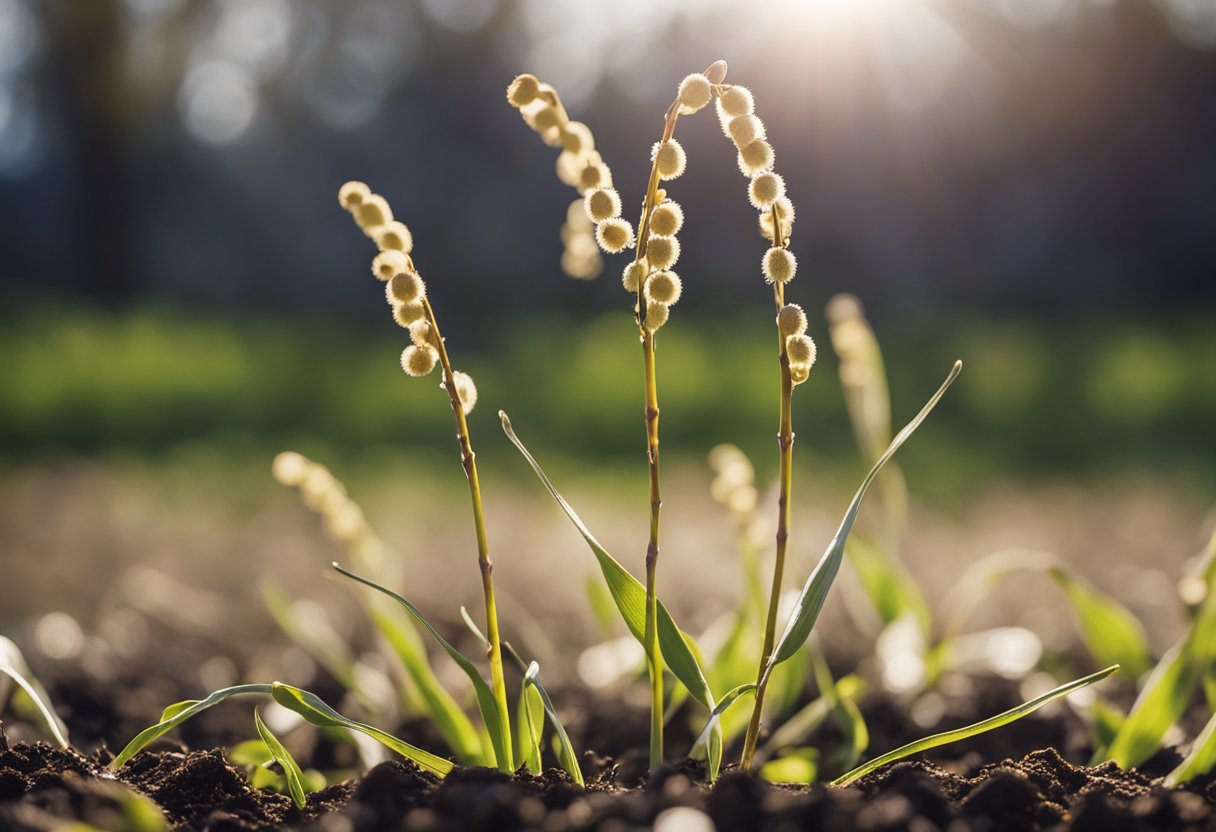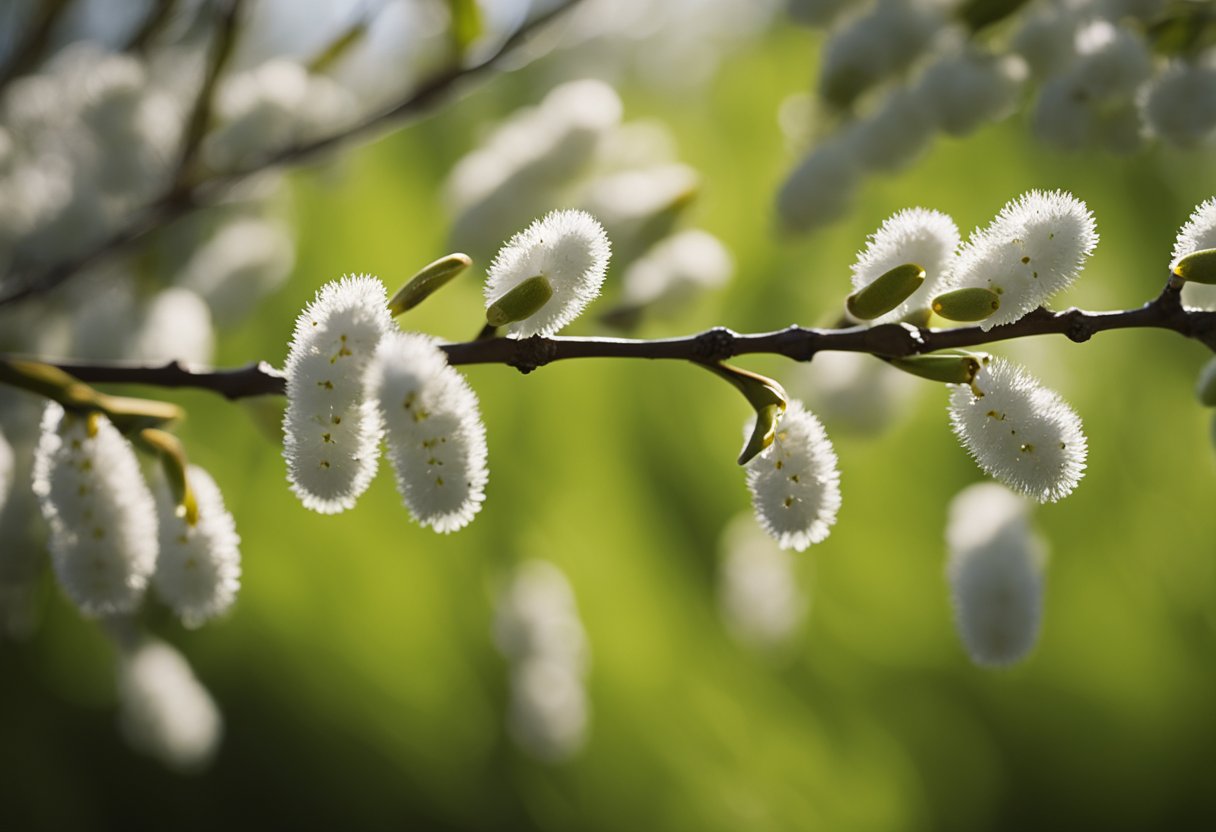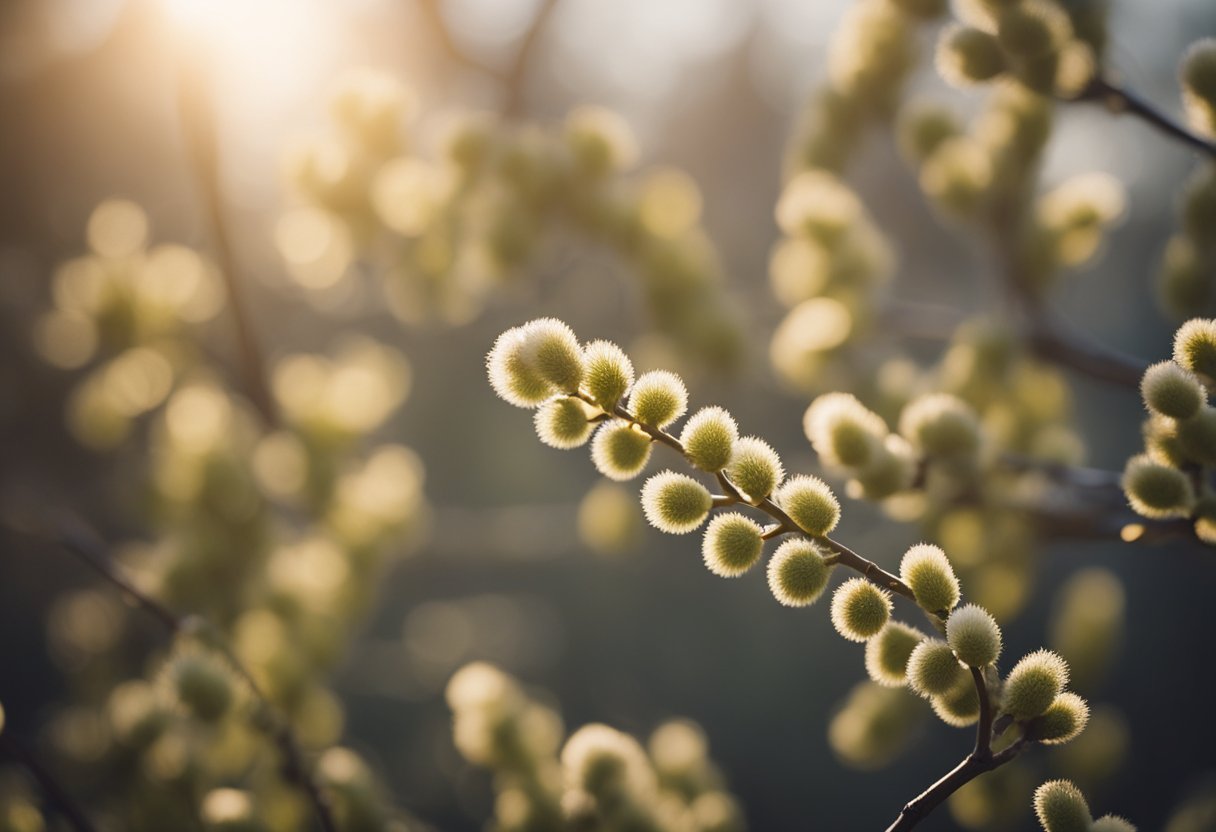How to Care for Pussy Willow: Tips and Tricks
Pussy willows are a popular type of shrub that are known for their soft and fuzzy catkins. These plants are easy to care for and can be grown in a variety of settings, including gardens, backyards, and even in pots on a balcony. Proper care is essential to ensure that your pussy willow thrives and produces healthy catkins year after year.

One of the most important aspects of caring for pussy willows is to ensure that they are planted in the right location. These plants prefer moist soil and partial shade, so it’s important to choose a spot that receives some sun but is also protected from the hot afternoon rays. Additionally, pussy willows require well-draining soil to prevent root rot, so be sure to choose a location that allows excess water to drain away.
Another key factor in caring for pussy willows is to provide them with the right nutrients. These plants benefit from regular fertilization, especially during their growing season. A balanced fertilizer with equal parts nitrogen, phosphorus, and potassium can help to promote healthy growth and abundant catkins. Additionally, pussy willows benefit from a layer of organic mulch around their base, which can help to retain moisture and prevent weed growth.
Understanding Pussy Willows
Botanical Profile
Pussy willows are deciduous trees or shrubs belonging to the Salicaceae family. The scientific name for pussy willows is Salix caprea, and they are also known as goat willow or glaucous willow. The pussy willow is a dioecious plant, meaning that it has male and female flowers on separate plants. The male flowers are usually more showy, with long, yellow stamens that give the plant its characteristic fuzzy appearance.
Pussy willows are native to Europe and Asia, but they have been widely cultivated in North America as well. The plant typically grows to be 10-20 feet tall, with a spread of 8-12 feet. The leaves of the pussy willow are oval-shaped and have a soft, fuzzy texture. They are usually a light green color and can grow up to 4 inches long.
Varieties and Their Characteristics
There are several varieties of pussy willow, each with its own unique characteristics. Salix discolor is a popular variety that is native to North America. It has a more upright growth habit than other pussy willows and can reach heights of up to 30 feet. The leaves of Salix discolor are a bluish-green color and have a waxy texture.
Another popular variety of pussy willow is the Hakuro Nishiki. This variety has variegated leaves that are pink and white in color. It is a smaller plant, typically growing to be 6-8 feet tall. The branches of the Hakuro Nishiki are also more slender than other varieties, giving it a more delicate appearance.
In general, pussy willows are easy to care for and require little maintenance. They prefer moist, well-drained soil and full sun to partial shade. Pruning should be done in the late winter or early spring to encourage new growth. Overall, pussy willows are a beautiful and unique addition to any garden or landscape.
Optimal Growing Conditions

Pussy willow is a hardy plant that can grow in a range of conditions. However, to ensure optimal growth and health, it is important to provide the right growing conditions.
Soil Requirements
Pussy willow grows well in well-draining soil that is rich in organic matter. Loamy soil that is moist and has a pH level between 6.0 and 7.5 is ideal for the plant. Adding leaf mold, compost, peat, or peat moss to the soil can help improve its quality and provide the necessary nutrients for the plant to thrive.
Light and Temperature
Pussy willow prefers full sun to partial shade. It can tolerate a range of temperatures but grows best in cool to moderate temperatures. It is important to protect the plant from extreme heat or cold as it can damage the plant.
Water and Humidity
Pussy willow requires moist soil to grow well. It is important to water the plant regularly, especially during dry periods. The plant also requires high humidity levels to thrive. Misting the leaves or placing a tray of water near the plant can help increase the humidity levels around the plant.
By providing the optimal growing conditions, pussy willow can grow into a healthy and attractive plant that adds beauty to any garden or landscape.
Planting and Propagation
Planting Guidelines
When planting pussy willow, it is important to choose a location that receives full or partial sunlight and has well-draining soil. The plant prefers moist soil, but it can tolerate periods of drought once established. Before planting, it is recommended to amend the soil with organic matter such as compost or aged manure to improve soil structure and fertility.
To plant, dig a hole that is twice the width of the root ball and slightly shallower than the depth of the root ball. Place the plant in the hole and backfill with soil, firming the soil around the base of the plant. Water the plant thoroughly after planting and regularly thereafter to keep the soil moist until the plant is established.
Propagating by Cuttings
Pussy willow can be propagated by taking hardwood cuttings in late fall or winter. To propagate, select a healthy stem that is at least 1/4 inch in diameter and 8-12 inches in length. Cut the stem at a 45-degree angle just below a node, and remove any leaves or side shoots from the bottom half of the stem.
Dip the cut end of the stem in rooting hormone and insert it into a pot filled with a moistened rooting medium such as perlite or vermiculite. Place the pot in a warm, bright location out of direct sunlight, and keep the soil moist but not waterlogged.
After several weeks, new growth should appear, indicating that the cutting has rooted. At this point, the cutting can be transplanted into a larger pot or directly into the garden. It is important to keep the new plant well-watered until it is established.
Overall, planting and propagating pussy willow is a straightforward process that can be accomplished by gardeners of all skill levels. By following these guidelines, gardeners can enjoy the beauty and benefits of this unique and versatile plant.
Maintenance and Care

Pruning and Shaping
Pussy willows require regular pruning to maintain their shape and size. Pruning should be done in late winter or early spring before the new growth appears. The branches should be cut back to a healthy bud or lateral branch. This will encourage the growth of new shoots and prevent the plant from becoming too leggy.
If the plant has become overgrown, it may require severe pruning. This involves cutting the plant back to within a few inches of the ground. This will encourage the growth of new shoots and rejuvenate the plant. However, severe pruning should only be done every few years as it can be stressful for the plant.
Fertilization Strategies
Pussy willows do not require a lot of fertilizer, but a light application in the spring can help promote healthy growth. A balanced fertilizer with equal amounts of nitrogen, phosphorus, and potassium can be applied around the base of the plant.
It is important not to over-fertilize as this can lead to excessive growth and weak branches. If the plant appears healthy and is growing well, additional fertilizer may not be necessary.
Mulching and Soil Health
Mulching can help maintain soil moisture and prevent weeds from growing around the plant. A layer of organic mulch, such as shredded leaves or bark, can be applied around the base of the plant.
Pussy willows prefer well-draining soil and may benefit from the addition of compost or other organic matter. However, it is important not to over-amend the soil as this can lead to excessive growth and weak branches.
In summary, regular pruning, light fertilization, and mulching can help maintain the health and appearance of pussy willows. Severe pruning should be done sparingly and only when necessary. By following these simple maintenance and care strategies, gardeners can enjoy the beauty of pussy willows for years to come.
Pest and Disease Management

Common Pests
Pussy willows are susceptible to several pests, including aphids, caterpillars, borers, and scale insects. Aphids are small, pear-shaped insects that feed on the sap of the plant and can cause stunted growth and distorted leaves. Caterpillars can chew on the leaves and stems of the plant, causing damage and reducing the plant’s overall health. Borers are larvae that bore into the stems of the plant, causing wilting and dieback. Scale insects are small, immobile pests that attach themselves to the stems and leaves of the plant and feed on the sap.
To manage these pests, it is important to regularly inspect the plant for signs of infestation. If an infestation is detected, it can be controlled with insecticidal soap or horticultural oil. Insecticides should be used sparingly and only when necessary, as they can harm beneficial insects and pollinators.
Disease Prevention
Pussy willows are also susceptible to several diseases, including canker, leaf spot, mildew, powdery mildew, and scab. Canker is a fungal disease that causes sunken lesions on the stems and branches of the plant. Leaf spot is a fungal disease that causes circular spots on the leaves. Mildew and powdery mildew are fungal diseases that cause a white or gray powdery coating on the leaves and stems. Scab is a fungal disease that causes brown or black spots on the leaves.
To prevent these diseases, it is important to keep the plant healthy and stress-free. This can be achieved by providing the plant with adequate water, nutrients, and sunlight. Pruning can also help improve air circulation and reduce the risk of disease. If a disease is detected, it can be treated with a fungicide. Fungicides should be used according to the manufacturer’s instructions and applied only when necessary, as they can harm beneficial insects and pollinators.
Seasonal Care

Winter Care
During late winter, pussy willow requires minimal care. The plant will be dormant during this time and will not require any pruning or fertilization. However, it is important to ensure that the plant is well-watered, especially if the winter is dry.
Spring and Summer Growth
As the weather warms up, pussy willow will begin to show new growth. This is the time to prune the plant, to encourage healthy growth and shape the plant as desired. Pruning should be done before the plant starts to flower, as pruning after flowering will remove the buds for next year’s blooms.
Pussy willow prefers full sun, but can tolerate some shade. It also requires lots of water, especially during the hot summer months. It is important to keep the soil moist, but not waterlogged, as this can lead to root rot.
Regular fertilization is also important during the growing season. A balanced fertilizer can be applied once a month to ensure that the plant has all the nutrients it needs to thrive.
By following these simple care instructions, pussy willow can be a beautiful addition to any garden.
Landscape and Ornamental Uses

Pussy willows are a popular choice for garden and landscape designs due to their unique and attractive appearance. They can be used in a variety of ways to add texture and interest to any outdoor space.
Designing with Pussy Willows
Pussy willows are versatile shrubs that can be used in a variety of landscape designs. They can be planted as a standalone specimen or used as a hedge or border plant. They can also be planted in groups to create a natural-looking thicket.
One of the most popular ways to use pussy willows in landscape design is to plant them near water features. The weeping pussy willow, also known as Salix caprea pendula, is particularly well-suited to this purpose. Its rounded shape and fuzzy catkins make it an attractive addition to any pond or stream.
Creating Flower Arrangements
Pussy willow branches are also a popular choice for flower arrangements. They can be used to add texture and interest to any floral design. The fuzzy catkins are particularly well-suited to creating a soft and delicate look.
When harvesting pussy willow branches for flower arrangements, it is important to wait until the catkins have fully developed. This will ensure that they are at their most attractive and will last longer in the arrangement.
Overall, pussy willows are a versatile and attractive plant that can be used in a variety of garden and landscape designs. Whether you are looking to create a natural-looking thicket or add texture to a floral arrangement, pussy willows are sure to impress.
Special Topics

Forcing Branches for Indoor Bloom
Pussy willow branches can be forced to bloom indoors, providing a beautiful and unique addition to any home. To do this, select branches that have not yet bloomed and cut them in late winter or early spring. Place the branches in a vase of water and keep them in a cool, dark place for several days. Once the buds begin to swell, move the vase to a brighter area, such as a sunny windowsill, and change the water every few days. The buds will eventually open, revealing soft, fuzzy catkins.
Environmental Impact and Considerations
Pussy willow is a native plant to North America, Asia, and Europe, and is commonly found in wetland areas such as stream banks. It has invasive roots and can cause soil erosion if planted near water sources. However, it is also a valuable plant for wildlife, providing food and habitat for a variety of animals.
In Canada, pussy willow is often used as a natural way to prevent soil erosion along riverbanks and streams. However, it is important to consider the potential impact on the environment before planting pussy willow in any area.
Pussy willow is also well-suited for cold winters and can withstand temperatures as low as -40°F. Its hardiness and adaptability make it a popular choice for gardeners in many regions.
Frequently Asked Questions

What are the best practices for watering a pussy willow plant?
Pussy willows require consistent moisture, so it is important to water them regularly. However, overwatering can cause root rot and other issues. The best practice is to water the plant deeply once or twice a week, depending on the weather and soil conditions. It is important to ensure that the soil is well-draining to prevent water from accumulating around the roots.
How often should I prune a pussy willow to maintain its health and shape?
Pussy willows can be pruned in late winter or early spring before new growth appears. Regular pruning can help maintain the plant’s shape and encourage healthy growth. It is recommended to prune back about one-third of the plant each year to prevent it from becoming too large and overgrown.
What type of soil is ideal for the optimal growth of pussy willows?
Pussy willows prefer moist, well-draining soil that is rich in organic matter. They can tolerate a range of soil types, but they do best in slightly acidic soil with a pH between 5.0 and 6.5. Adding compost or other organic matter to the soil can help improve its texture and fertility.
Can pussy willow plants be grown indoors, and if so, what are the specific care instructions?
Pussy willows can be grown indoors in containers, but they require a cool, bright location with plenty of sunlight. They also need consistent moisture, so it is important to water them regularly. Fertilize the plant every two weeks with a balanced, water-soluble fertilizer during the growing season, and prune it back in late winter or early spring to maintain its shape.
What common pests and diseases affect pussy willows, and how can they be treated?
Pussy willows are relatively resistant to pests and diseases, but they can be affected by aphids, scale insects, and powdery mildew. These issues can be treated with insecticidal soap or horticultural oil, or by pruning affected areas. It is important to monitor the plant regularly for signs of pests or disease and take action promptly to prevent further damage.
How can I propagate pussy willow branches to grow new plants?
Pussy willows can be propagated by taking stem cuttings in late winter or early spring before new growth appears. Cuttings should be about 6 inches long and taken from the previous year’s growth. Dip the cut end of the stem in rooting hormone and plant it in a container filled with moist potting mix. Keep the container in a warm, bright location and water it regularly until new growth appears.


